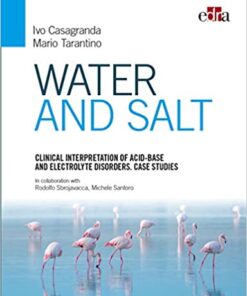Management of Intensive Care: Guidelines for Better Use of Resources
$10
ntensive Care Medicine has been continuously growing and expanding, culturally, technically and geographically. Monitoring and instrumentation are continuously improving and more and more hospitals are getting Intensive Care facilities. The costs have proportionally increased over the years, so that ICUs represent today a major cost for health structures. Since the available resources are limited, a real need is emerging to set the limits and indications of Intensive Care. It is understood that the problem not only involves medical considerations, but also ethical and economical aspects of the utmost importance. For the first time in Europe, this book edited by Reis Miranda and his colleagues tackles systematically the many structural aspects of the European Intensive Care. The organisation and financing of health care in the Old Continent is deeply different from the American one, and the results and consequent proposals obtained in the USA cannot simply be transferred to this side of the Atlantic Ocean. Weare extremely pleased to welcome this first European attempt to discuss the Intensive Care problem. It lays no claims to giving definite replies in a continuously developing field, but it will surely become the basis for future discussions and proposals. I am particularly happy that this work has mainly developed within the European Society of Intensive Care, whose final target is to ensure a common standard of therapy in our old Europe, beyond national differences. We warmly congratulate the authors, and I am sure that their work will find wide diffusion and consent.
Related Products
EMERGENCY MEDICINE BOOKS
Emergências Neurocirúrgicas, 3rd Edition (Original PDF from Publisher)
EMERGENCY MEDICINE BOOKS
Point of Care Ultrasound in Critical Care (ePub+Converted PDF)
EMERGENCY MEDICINE BOOKS
Receituário de Bolso: Emergências Médicas, 1st edition (Original PDF from Publisher)
EMERGENCY MEDICINE BOOKS
AMLS: Advanced Medical Life Support, 3rd edition (Original PDF from Publisher)
EMERGENCY MEDICINE BOOKS
EMERGENCY MEDICINE BOOKS
EMERGENCY MEDICINE BOOKS
100 Cases in Acute Medicine, 2nd Edition (Original PDF from Publisher)
EMERGENCY MEDICINE BOOKS
Emergenze respiratorie. La gestione del paziente acuto e critico (EPUB3)
EMERGENCY MEDICINE BOOKS
EMERGENCY MEDICINE BOOKS
EMERGENCY MEDICINE BOOKS
The Walls Manual of Emergency Airway Management, 6th Edition (EPUB3)
EMERGENCY MEDICINE BOOKS
The Washington Manual of Emergency Medicine, SAE (Original PDF from Publisher)
EMERGENCY MEDICINE BOOKS
MCQS in Critical Care Medicine (Original PDF from Publisher)
EMERGENCY MEDICINE BOOKS
Mechanical Circulatory and Respiratory Support (Original PDF from Publisher)
EMERGENCY MEDICINE BOOKS
EMERGENCY MEDICINE BOOKS
EMERGENCY MEDICINE BOOKS
EMERGENCY MEDICINE BOOKS
Critical Care Transport, 3rd Edition (Original PDF from Publisher)
EMERGENCY MEDICINE BOOKS
Evolution of EMS: COVID-19 Guidance for EMS Providers (Original PDF from Publisher)
EMERGENCY MEDICINE BOOKS
Emergency Pediatric Care Course Manual, 4th Edition (Original PDF from Publisher)
EMERGENCY MEDICINE BOOKS
French AMLS: Support Avance De Vie Medicale, 3e Édition (Original PDF from Publisher)
EMERGENCY MEDICINE BOOKS
Advanced First Aid, CPR, and AED, 8th Edition (Original PDF from Publisher)
EMERGENCY MEDICINE BOOKS
Standard First Aid, CPR, and AED, 8th Edition (Original PDF from Publisher)
EMERGENCY MEDICINE BOOKS
Emergencies in Neuromuscular Disorders (Original PDF from Publisher)
EMERGENCY MEDICINE BOOKS
EMERGENCY MEDICINE BOOKS
EMERGENCY MEDICINE BOOKS
EMS Field Guide BLS Version: Revised 2021, 9th Edition (Original PDF from Publisher)
EMERGENCY MEDICINE BOOKS
EMERGENCY MEDICINE BOOKS
Emergency & Critical Care Pocket Guide, Revised Eighth Edition (Original PDF from Publisher)
EMERGENCY MEDICINE BOOKS
EMERGENCY MEDICINE BOOKS
Neuromonitoring in Neonatal and Pediatric Critical Care (Original PDF from Publisher)
EMERGENCY MEDICINE BOOKS
Emergency Imaging of At-Risk Patients: General Principles (Original PDF from Publisher)
EMERGENCY MEDICINE BOOKS
Manual of Eye, Ear, Nose, and Throat Emergencies (Volume 1) (EPUB)
EMERGENCY MEDICINE BOOKS
Bien débuter – Urgences (French Edition) (Original PDF from Publisher)
EMERGENCY MEDICINE BOOKS
Cases in Pre-Hospital and Retrieval Medicine, 2nd edition (Original PDF from Publisher)
EMERGENCY MEDICINE BOOKS
Perioperative Quality Improvement (Original PDF from Publisher)
EMERGENCY MEDICINE BOOKS
Practical Guide to Interventional Pulmonology (Original PDF from Publisher)
EMERGENCY MEDICINE BOOKS
The Toxicology Handbook, 4th edition (Original PDF from Publisher)
EMERGENCY MEDICINE BOOKS
Atlas of Emergency Medicine Procedures, 2nd Edition (Original PDF from Publisher)
EMERGENCY MEDICINE BOOKS
EMERGENCY MEDICINE BOOKS
Atlas of Emergency Imaging from Head-to-Toe (Original PDF from Publisher)
EMERGENCY MEDICINE BOOKS
Emergency Medicine Board Review for the Visual Learner (Original PDF from Publisher)
EMERGENCY MEDICINE BOOKS
Arterial Blood Gas Interpretation in Clinical Practice (Original PDF from Publisher)
EMERGENCY MEDICINE BOOKS
Der Praxisanleiter im Rettungsdienst, 2e (German Edition) (Original PDF from Publisher)
EMERGENCY MEDICINE BOOKS
Oncologic Emergency Medicine: Principles and Practice, 2nd Edition (Original PDF from Publisher)
EMERGENCY MEDICINE BOOKS
Textbook of Critical Care including Trauma And Emergency Care, 2nd edition (Converted PDF)
EMERGENCY MEDICINE BOOKS
EMERGENCY MEDICINE BOOKS
EMERGENCY MEDICINE BOOKS
Occupational Therapy in Acute Care, 2nd Edition (Original PDF from Publisher)
EMERGENCY MEDICINE BOOKS
EMERGENCY MEDICINE BOOKS
Navigating the ICU: A Guide for Patients and Families (EPUB)
EMERGENCY MEDICINE BOOKS
Communication in Emergency Medicine (Original PDF from Publisher)
EMERGENCY MEDICINE BOOKS
Eye Movements in the Critical Care Setting (Original PDF from Publisher)
EMERGENCY MEDICINE BOOKS
Tratado de medicina intensiva, 2nd edition (Original PDF from Publisher)
EMERGENCY MEDICINE BOOKS
Mechanical Ventilation from Pathophysiology to Clinical Evidence (Original PDF from Publisher)
EMERGENCY MEDICINE BOOKS
Critical Care of COVID-19 in the Emergency Department (Original PDF from Publisher)
EMERGENCY MEDICINE BOOKS
Handbook of Intravenous Fluids (Original PDF from Publisher)
EMERGENCY MEDICINE BOOKS
Rapid Interpretation of Ventilator Waveforms, 3rd Edition (EPUB)
EMERGENCY MEDICINE BOOKS
EMERGENCY MEDICINE BOOKS
CMC Vellore Handbook of Emergency Medicine, 3rd Edition (Original PDF from Publisher)
EMERGENCY MEDICINE BOOKS
Textbook of Emergency & Trauma Care (Original PDF from Publisher)
EMERGENCY MEDICINE BOOKS
A Guide to Mechanical Ventilation in Emergency Room, 2nd Edition (Original PDF from Publisher)
EMERGENCY MEDICINE BOOKS
EMERGENCY MEDICINE BOOKS
Annual Update in Intensive Care and Emergency Medicine 2022 (Original PDF from Publisher)
EMERGENCY MEDICINE BOOKS
EMERGENCY MEDICINE BOOKS
Fundamentals of Pharmacology for Paramedics (Original PDF from Publisher)
EMERGENCY MEDICINE BOOKS
Preparing Nurses for Disaster Management: A Global Perspective (EPUB + Converted PDF)
EMERGENCY MEDICINE BOOKS
Pocket Emergency Medicine, 5th Edition (EPUB + Converted PDF)
EMERGENCY MEDICINE BOOKS
The Washington Manual of Critical Care, SAE (Original PDF from Publisher)







































































































